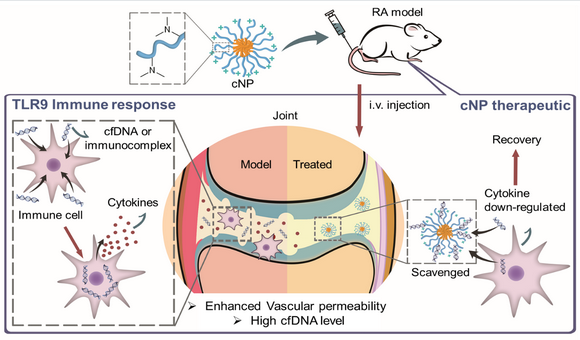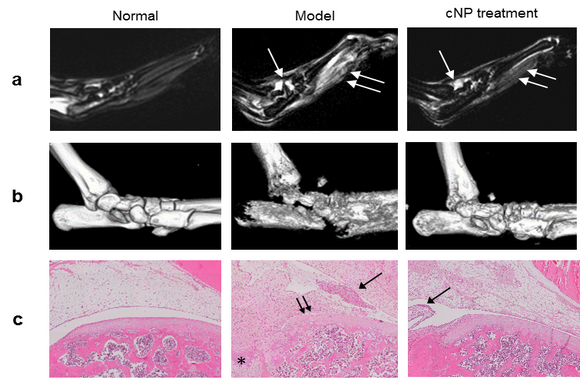Prof. Yongming Chen and Prof. Lixin Liu’s group made great progress in the study of polymer materials inhibiting Rheumatoid Arthritis
Source: School of Materials Science and Engineering
Written by: School of Materials Science and Engineering
Edited by: Wang Dongmei
Rheumatoid Arthritis (RA), as a common chronic autoimmune disease, afflicts approximately 1 % of population worldwide. The autoantigen would activate the immune system to secrete inflammatory cytokines to induce bone and cartilage erosion as well as joint swelling, which would seriously affect RA patients’ life and work. Present therapeutic drugs used in clinical treatment mainly include disease-modifying anti-rheumatic drugs (DMARDs) like methotrexate and biologics such as anti-TNF-, but they show strong side effects and also weaken the immune system. Moreover, biologic drugs are too expensive for patients in developing countries. Thus, it is still a great challenge to find a new strategy to treat RA. Recent research indicated that cell-free DNA (cfDNA) level in the synovial fluid of patients was greatly elevated. Also cfDNA could be internalized into immune cells and activate the Toll-like Receptors (TLR) to cause abnormal immune response.
Recent study in Functional Biomaterial Center of Sun Yat-sen University showed that using cationic polymer materials to scavenge cfDNA could inhibit cfDNA-induced inflammation in primary cells of RA patient. It also showed that the cationic nanoparticles (cNP) could accumulate in the inflamed joint of RA animal model due to the enhanced vascular permeability caused by the inflammation, thus cNP could obviously inhibit the joint swelling and the bone and cartilage damage, and even recover partial mobility of RA animal model. This study indicated that cNP with high DNA binding efficiency could greatly inhibit TLR9 activation in immune cells and the cfDNA-induced inflammatory response in primary synovial fluid mononuclear cells and fibroblast-like synoviocytes of RA patients. After i.v. injection of cNP to treat RA rat models, the joint effusion and severe soft tissue swelling were significantly reduced, the erosive bone damage was arrested, and inflammatory cell infiltration at the synovium and articular cavity was decreased, demonstrating that cNP had great therapeutic efficacy to RA. Furthermore, treatment with cNP also led to partial mobility recovery in the RA rats, suggesting that cNP could restore the basic mobility in advanced RA stage.

Fig 1. Mechanism of using cNP to scavenge cfDNA to inhibit inflammatory response for treating RA

Fig 2. Representative MRI images of hindpaws (a), representative micro-CT images of the ankle joints (b), and representative HE staining of knee joints (c) of RA model rats after cNP treatment.
This is the first time to use cationic nanomaterials as cfDNA scavengers to treat RA, implying that polymer materials might treat RA as drugs, a new strategy for RA medication. The related results has filled patent and been published as an article “Cationic Nanoparticle as an Inhibitor of Cell-Free DNA-Induced Inflammation” in Nature Communications on October 16, 2018 (link: https://www.nature.com/articles/s41467-018-06603-5). Huiyi Liang, a Ph.D. student from School of Materials Science and Engineering, Sun Yat-sen University, is the first author. Prof. Yongming Chen and Prof. Lixin Liu from School of Materials Science and Engineering, Sun Yat-sen University, Prof. Jun Shen from Sun Yat-sen Memorial Hospital, and Prof. Kam W. Leong from Columbia University are co-authors. Financial support from the Guangdong Innovative and Entrepreneurial Research Team Program, the National Natural Science Foundation of China, and Natural Science Foundation of Guangdong Province is gratefully acknowledged.
